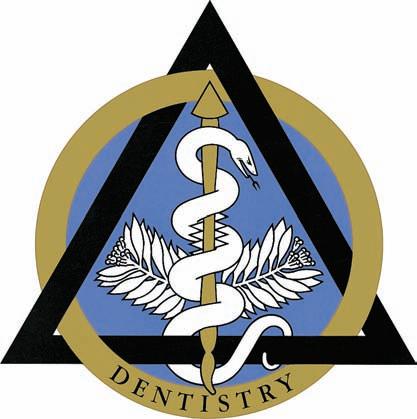
29 minute read
ChaPTer 4 Practice and Facility Setups
Chapter
4Practice and Facility Setups
Advertisement
Objectives Upon completion of this chapter, the reader should be able to identify and understand terms related to the following: 1. Dental professionals. Name and discuss the different roles of the professionals who render dental care. 2. Places of employment. Describe the various places and organizational structures in the field of dentistry where qualified and interested parties work. 3. Dental hand instruments. List and explain the use of the major hand instruments used in dental procedures. 4. Rotary dental instruments. List and explain the use of the major rotary instruments used in dental care procedures. 5. Dental facility operative equipment. Describe the common operative equipment used in the dental operatory and office environments.
Dental Professionals
Each profession speaks a language of its own, using terms or words connected with its common procedures, personnel, techniques, and instrumentation. People who are involved with, use the language of, and participate in each of these occupations are said to be professionals of that occupation. Others who are not related to or familiar with this profession are called lay people. Each of the many different types of personnel associated with the dental profession performs a special function or meets a particular need. Some are directly involved with the practice, and others provide support.
Dentist
The dentist, who is a Doctor of Dental Surgery (DDS) or a Doctor of Medical Dentistry (DMD), diagnoses, performs, and monitors the dental care of patients. Various specialists, who complete extended studies, training, and testing,
perform the following specific duties or skills of their particular specialty. The official ADA-recognized special areas are listed here: prosthodontist (prahs-thoh-DOHN-tist): replaces missing teeth with artificial appliances such as dental crowns, full mouth dentures, or partial bridgework. periodontist (pear-ee-oh-DOHN-tist): treats diseases of periodontal (gingiva and supporting) tissues. orthodontist (or-thoh-DON-tist): corrects malocclusion and improper jaw alignment. pediatric (pee-dee-AT-trick) dentist: performs dental procedures for the child patient, also called pedodontist (PEE-doh-don-tist). endodontist (en-doh-DAHN-tist): treats the diseased pulp and periradicular structures. oral and maxillofacial (mack-sill-oh-FAY-shal) surgeon: performs surgical treatment of the teeth, jaws, and related areas. public health dentist: works on causes and prevention of common dental diseases and promotes dental health to the community or general population. oral pathologist: studies the nature, diagnosis, and control of oral diseases. oral and maxillofacial radiologist: is concerned with the production and interpretation of radiant energy images or data regarding the oral and maxillofacial regions. forensic (for-EN-sick) dentist: discovers and uses pathological evidence for legal proceedings; forensic dentistry is not yet established as a recognized specialty but is organized and related to a particular type of dental care.
Each licensed dentist is permitted to perform general dental procedures in any or all of the various areas of dentistry. Some dentists, while not technically specialists, may limit their practice to only one specialty area such as oral surgery, orthodontics, or the like, servicing only those type of patients. Other dentists may advertise and perform procedures in special dental areas of interest, such as amalgam free, cosmetic, diagnostic, implant, sedation, TMJ, holistic dentistry, and so forth.
The official organization of the dentists and dental specialists, the American Dental Association (ADA) has branches on the state (constituent) and local (component) levels. As illustrated in Figure 4-1, the official seal of the ADA is a triangle containing the Greek letter D (triangle) for dentistry and a serpent on the staff indicating a healing art. The branch on one side contains 20 leaves for the deciduous teeth, and the branch with 32 leaves on the other side represents the permanent teeth. All symbols are encircled with the ring of health.
Registered Dental Hygienist
The registered dental hygienist (RDH) completes postsecondary education in dental hygiene instruction. An RDH is board-tested in theory and proficiency and state registered. Most states require the presence of the responsible dentist in the clinical setting, but some states permit independent dental hygiene practice in outside areas. The hygienist is concerned with the prevention
Figure 4-1
ADA Logo
Dental Assistant
of dental disease, specializing in the cleaning, polishing, and radiographing of teeth, periodontal treatment, fluoride and sealant application, and patient education. The hygienist, if educated, tested, and certified as state approved, may also perform some operative or supportive procedures such as nitrous oxide and/or anesthetic injection administration, application of microbial agents, patient assessment, and interpretation of X-rays and testing results. The dental hygienist who completes the advanced ADHA educational curriculum may earn ADHP (advanced dental hygiene practitioner or dental therapist) certification. The official organization of hygienists is the American Dental Hygienist Association (ADHA), with branches at the state (constituent) and local (component) level.
The dental assistant aids the dentist in diagnosis, treatment, dental care, and general duties. The dental assistant may be an RDA (state registered dental assistant), a CDA (nationally certified dental assistant), or a state-registered dental assistant with expanded functions (RDAEF). Each state regulates the permissible duties, functions, and designated titles of expanded duty personnel.
Specialized certifications are offered by the Dental Assisting National Board (DANB). These certifications include CDA (Certified Dental Assistant) and COA (Certified Orthodontic Assistant). Certificates of Competency can be earned in Radiation Health and Safety (RHS) and Infection Control (ICE). The official dental assistant organization is the American Dental Assistants Association (ADAA), with constituent, component, and local level branches.
Dental Laboratory Technician
The dental laboratory technician performs dental lab procedures under written orders from a licensed dentist. The technician may receive on the job training (OJT) or be educated in a laboratory or school setting. The technician may be a certified dental technician (CDT). The official organization for these professionals is the National Association of Dental Laboratories (NADL), which also has state and local level branches.
Denturist
The denturist (DEN-ture-ist) independently specializes in the construction of dentures and may practice only in those states that recognize, license, and permit this profession.
Other Dental Professionals
Other related dental professionals include dental supply/detail persons, dental equipment technicians, and dental manufacturers and suppliers. Some dental professionals dedicate their careers to research, education, and the development of oral medicine.
Places of Employment
Qualified and interested parties may work in various places and organizational structures in the field of dentistry, as described in the following list: = Solo: dental practice owned and operated by a single dentist or a practice that is owned by a dentist who contracts with another dentist (an associate) to work in the establishment with the owner. = Partnership: dental practice owned and operated equally by two or more dentists. = Group: dental practice employing a multitude of dentists; may be incorporated and owned by the working dentists or owned and operated by an outside corporation or dental health plan. = Clinics and hospitals: a clinic setting or hospital care center that offers dentistry services. Many hospitals grant privileges to dentists to bring difficult or compromised patients for dental care using hospital services; oral surgeons may be staff members and work in the hospital and in their private offices. = Specialty practice: various specialists work in private offices or facilities concerned with their training. Public health specialists may work in outpatient clinics, field establishments, schools, and offices. Forensic specialists may work in the lab, field, and court. = Miscellaneous practice sites: includes research, insurance companies, education, publication, specialty houses, employment and recruiting agencies, charity clinics, and other areas.
Dental Hand Instruments
Each profession employs its own type and kind of instrumentation. Just as a baseball team requires balls, bats, masks, and gloves, dentistry requires specialized equipment for operation. Some tools are in common use in all aspects of dentistry, and others are constructed for various specialized procedures. Following are the standard instruments, grouped by their related family of use.
Hand Grasp Instruments
Hand instruments may have one working end (single-ended) or a working end at each of the opposite sides (double-ended). Working ends on the same instrument may vary in size, function, or location of operative site locations. Many instruments are named for an inventor or school where they were designed. Instruments are grouped into families according to function and are constructed of various materials from stainless steel to hard resin. All instruments have the following three components as shown in Figure 4-2: = Shaft or handle: used to grasp the instrument; supplied in various weights, diameters, and surfaces that may be smooth, padded (tactile), grooved or serrated; may be rounded or octagonal-shaped plastic or metal with manufacturer’s name and/or formula code etched on one side. = Shank: connects the handle to the working end; sometimes called the instrument neck. The shank may be straight, curved, or angled to accommodate specific areas of the mouth. = Working end: also called blade or nib; rounded end is the toe; the pointed end is the tip, which may be beveled, curved, scooped, or spoon shaped and present on both ends.
Basic Dental Setup
Dental hand instruments are conveniently grouped into families of use, such as diagnostic, restorative, finishing, surgical, periodontal, and so forth, but this does not limit their use. A hand instrument may be used at the operator’s choice in any specific duty or function desired. The instruments in this chapter will be grouped and shown in families.
Basic or Diagnostic Grouping
The basic or diagnostic dental setup is an instrument collection composed of a mouth mirror, explorer, periodontal probe, cotton forceps or pickup, and a piece of 2 × 2 gauze and is used in most arrangements, alone or with other instruments (Figure 4-3). A setup is also called an armamentarium (ar-mah-men-TARE-ee-um).
Working end
Shank
Figure 4-2
Components of hand instruments
Handle
Courtesy of Integra LifeSciences Corporation through Integra Miltex
mouth mirror: used for reflection, retraction, and visual observation; supplied in various sizes from 1 (16 mm) to 6 (26 mm) and may have one side or double-sided plain faces or faces that magnify the view. Some are solid, one piece; others have cone screw-in handles. explorer: a sharp, flexible, pointed instrument used to detect caries and calculus; to explore restorations, surfaces, and furcations; to make location marks; and to pick up cotton points or materials. This tool is supplied in multiple shapes as single or double ended with an explorer edge on one side and another type of edge on the opposite side. cotton forceps: tweezer-like pinchers used to transport materials to or from the mouth; also called dressing pliers; available with or without serrated tips.
Figure 4-3
Basic or diagnostic dental setup: (A) mouth mirror, (B) explorer, (C) cotton pliers, (D) periodontal probe
Periodontal Grouping
(A)
(B)
(C)
(D)
periodontal probe: a longer pointed instrument with measured marks on the tip; used to assess depths of tissue pockets; available with a round or flat blade and may be color-coded to help determine measurements. expro (EX-pro): double-ended instrument with a diagnosing probe tip at one end and an explorer tip at the other end.
The periodontal group is a family of instruments used to treat and care for the gingival and periodontal tissues. They will be discussed more in Chapter 16, Periodontology. scaler: thin-bladed hand instrument with pointed tip and two cutting edges; used to scale or (scrape off) supragingival hard deposits from teeth; designed for quadrant use. sickle scaler: sharp blade in the shape of a sickle; used to remove calculus from tooth surfaces. scallette: hygiene instrument combining a scaler on one tip and a curette on the other tip to save time and tray space during treatment. curette (kyou-RETT): rounded-tipped thin blade with a longer neck and two cutting edges; designed for specific tooth area and used to remove subgingival deposits. implant scaler/curette: nonmetallic, resin-tipped instrument, designed to remove deposits around titanium implant abutments. Some thin bladed, titanium scalers/curettes have been developed to use safely and not mar the metal implant abutments. periodontal file: hand instrument with rough edge or teeth working surface; used to smooth in root planning.
Restorative Grouping
periodontal knife: hand instrument with flat-bladed incision tip of various shapes and angles; used to remove or recontour soft tissue. scalpel (SKAL-pell): handle for attachment of blades of assorted sizes and shapes; used to incise (cut into) or remove tissue; also used in specialized dental procedures.
The restorative grouping is an assortment of hand instruments used to remove decay, make preparations, and restore tooth surfaces (Figure 4-4): excavator (ECKS-kah-vay-tor): hand instrument with long-necked, cup-like, sharp-edged blades; used to remove soft decayed tissue from preparations; also may be called spoon excavators. gingival margin trimmer: hand instrument with long, slender, curved, flat blade; used to break away enamel margins during tooth preparations and smooth or refine the cavity preparation. hoe: smaller bladed instrument with a tip resembling a farm hoe; used to break or pull away enamel tissue during preparations. hatchet: hand instrument with a sharp-edged hatchet-like tip; used to remove hard tissue. chisel: hand instrument with cutting edge that is used to cut and plane away enamel and dentin. Chisels have straight shanks, or a curved shank, such as the Wedelstaedt chisel, or may have an extra angled shank, such as the bin-angle chisels. cleoid (KLEE-oyd)/discoid (DISK-oyd) carver: double-ended, long-necked, carving instrument with a pointed tip on one end (cleoid) and a discshaped blade on the other end (discoid); used to carve anatomy features in newly placed restorations or can be used to remove decay and tooth tissue during cavity preparations. carver: thin-bladed hand instrument used to remove decay or carve newly placed restorative material; blade faces come in various shapes. Popular types are the Hollenback, Wards, and Frahms carvers.
Filling and Finishing Grouping
After the preparation is complete, it must be filled with an appropriate restorative material and then restored to a natural appearance and function. The following instruments may be used to complete this process (also shown in Figure 4-4). plastic filling instrument (PFI): hand instrument with a flat blade; used to carry, transfer, and pack materials, or to carve restorative material while it is still in a movable or plastic stage. condenser: hand instrument with a thick, rounded, or oval-shaped flat head that is sometimes serrated. It is used to pack or condense restorative material into the cavity preparation. Double-ended ones vary in sizes and/or surfaces. burnisher: hand instrument with a smooth, rounded head that comes in various shapes; used to smooth out restorative material or other metal surfaces, such as a matrix strip.
(A) Excavator
(B) Spoon Excavator
(C) Cleoid/Discoid
(D) Gingival Margin Trimmer
(E) Hoe
(F) Hatchet
(G) Chisel/ bin-angle
(H) Chisel/Wedelstaedt (I) Chisel/straight
Figure 4-4
Restorative group and filling and finishing group (Continues)
(J) Carver/Hollenback
(K) Carver/Frahm
(L) Plastic Filling Instrument
(M) Composite Placement Instrument
(N) Condenser
(O) Condenser
(P) Burnisher


(S) Matrix (Q) Burnisher
(R) Amalgam Carrier
(T) Band (U) Well
Courtesy of Integra LifeSciences Corporation through Integra Miltex
Figure 4-4
(Continued) amalgam carrier: hand instrument with holding cylinder for the transfer of amalgam material while in a plastic form; it has a spring lever pusher to expel the material into the preparation. The instrument is supplied in assorted sizes from 1.5 to 3.2 mm with various cylinder materials on the end tips. They are color-coded for size (red = jumbo, yellow = large, and white = medium).
Another type of amalgam carrier is the amalgam gun with a thumb spring push to expel the material. Both amalgam carriers may be loaded by pressing the plastic load of restorative material into the amalgam well. matrix (MAY-tricks) holder, matrix strip, and wedge: holder device used to maintain artificial wall (matrix strip) around the tooth preparation. A wooden or resin triangular wedge is used to hold the strip in place and prevent the material from leaking. Matrix retention will be discussed further in Chapter 10, Tooth Restorations. loupes: though not considered an instrument, eye loupes are glasses used for magnification, precision, and identification purposes, and are required in many procedures. Magnification power is from 2× to 8× and may have light sources and a splash side for sanitary purposes.
Evacuation
Assorted Instruments
Evacuation of the mouth is accomplished by using tips that are inserted into suction tubing. These tips are placed in the mouth and used to remove moisture, debris, and other matter. The two types of handheld evacuator tips commonly used in saliva evacuation are: high volume evacuator (HVE): curved, metal or resin, beveled tip with a large hole, inserted into a high evacuation tube system handle with off/on and intensity controls; used for gross removal of fluids and debris from the mouth. saliva ejector tip: smaller suction tip that is inserted into the evacuation tubing from the dental unit; used for a steady, constant fluid removal from the oral cavity.
Various mechanical devices are used to isolate and maintain a dry field such as the disposable Isolite illuminator (see Figure 4-5), a device placed into the mouth that will serve as a tongue retainer, and a luminated evacuation unit that is maintained by the patient in a bite block position. Insertion of gauze pads or commercial absorbent pads near the saliva duct in the cheek and rubber dam placement can help to maintain some fluid control. Some units have a cuspidor (KUSS-pih-dore = basin) nearby for patients to empty their mouths.
Other instruments, such as scissors, spatulas, knives, and pliers, are used interchangeably in any family or instrument group. Each dental procedure will need specific variations of the basic instruments mentioned previously and call for specialized instruments and materials as required. Instruments may be color-coded by placing a colored band on the shaft to indicate the type of instrument, the operatory/treatment room of use, the operator, the type of setup, or any other way of grouping. They may be sterilized in colored trays arranged in a pre-setup to match this coding. Use of sterilizing cassettes or trays will be discussed in Chapter 5, Infection Control.
Figure 4-5
Isolite—one unit delivers isolation, illumination, retraction, and aspiration.
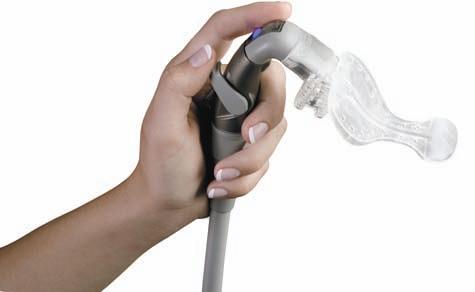
Rotary Dental Instruments
Rotary instruments are power-driven tools that operate in a circular motion at various speeds. The rate of speed or rpm (rotations per minute) determines the classification of the instrument. The handpiece holds and operates the inserted instrument. It is classified as slow, high, or ultra-high speed, depending upon its rpm (10,000 to 400,000). Rotation is achieved by a belt-driven electric turbine or a compressed air system. High-speed handpieces have an attached angled head that holds a friction grip (FG) bur, diamond, or point that is inserted into the head and tightened into place. Slower handpieces may be used independently or may accommodate the following smaller handpieces (Figure 4-6): contra-angle handpiece (CAHP): handpiece with an obtuse angled head (more than 90 degrees). A CAHP is inserted into the power unit’s straight handpiece and is used to gain access to posterior teeth and difficult areas. right-angle handpiece (RAHP): handpiece with the head at a 90-degree angle; is inserted and connects into the power unit’s handpiece; employed in general use throughout the oral cavity. prophy (PRO-fee) angle handpiece (PHP): small prophylaxis handpiece rotary angle with a 90-degree angle head; has a limited opening in the working end for polishing cups or brush placement. The PHP is inserted into a slow-speed handpiece and used to polish teeth. Many PHPs are disposable, and some may be battery powered with swivel heads and optical light sources. fiber-optic handpiece: specific slow or high-speed handpiece that supplies a light source to the operative site for improved vision.
(B) (C) (D)
Figure 4-6
Low-speed handpiece with attachments: (A) handpiece, (B) contra-angle, (C) right-angle or prophy angle, with rubber cup, (D) round bur with long shank
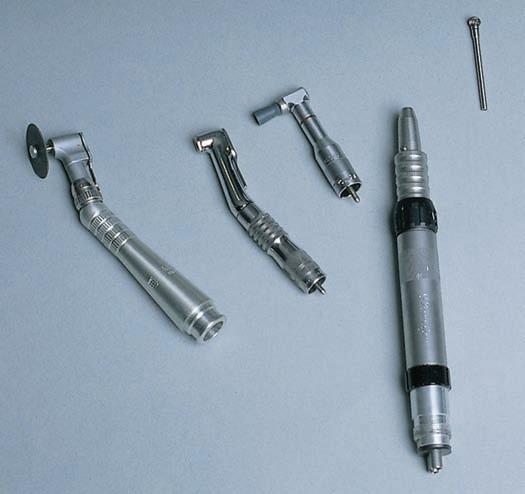
(A)
© Cengage Learning 2013
rheostat (REE-oh-stat): a foot pedal or lever that is used to regulate the speed of the handpiece.
Although not considered standard operative handpieces used for restorative and tissue-removing procedures, other dental instruments that are handheld can be attached to the specialized mobile stand or movable over-thepatient tray called a delivery system. Each practice chooses which types of handpieces to have available for that practice (see Figure 4-7). Along with the basic air/water syringe, the selective combination can be chosen from: air abrasion: air-powered handpiece delivering abrasive aluminum oxide powder or sodium bicarbonate under force to clean or prepare tooth surfaces or remove some carious tissue (Figure 4-8). ultrasonic handpiece: high-speed vibration-scaling tips used for scaling and curettage purposes; sometimes called ultrasonic scaler. curing light handpiece: handheld device that focuses a light beam to cure or
“set” specified materials. intraoral camera: handpiece with a small camera situated in the head; used to transmit various views of the oral setting. electrosurgery handpiece: combination of assorted metal tips that fit into a probe handle; these tips pass electrical currents that incise and coagulate the blood in a surgical procedure. laser handpiece: photon handpiece that emits a precise light energy wavelength that is concentrated to perform specialized tasks; various wavelengths are utilized for a specific target or procedure, such as tooth whitening, caries removal, or surgical gingivectomy.

Figure 4-8 Air abrasion unit

Courtesy of Midwest Dental Products Corporation, a division of DENTSPLY International
caries detection scanner: a noninvasive laser scan that detects early decay in occlusal areas. implant drilling unit: lighted, digitally controlled drilling handpiece with sterile irrigation that is used to smooth alveolar bone, drill operative sites, and install implants.
All dental handpieces are expensive items and must be maintained, sterilized, and cared for in the manner specified by the manufacturer of the instrument.
Handpieces may be used to hold the burs, mandrels, mounted stones, and discs that are used in restorations and chairside dental procedures. The dental bur is the most commonly used rotary item and is employed in cavity preparation and restorations. A bur has three parts (see Figure 4-9): = Shank: the end of the bur that is inserted into the handpiece. The type of end is determined by the requirements of the power handpiece. The assortment of burs includes the friction grip (FG), right angle (RA), or handpiece (HP) that is placed directly into a straight handpiece. The length of the shank—long, short, or pedodontic—varies according to the type of bur or area involved.
Figure 4-9
Parts of bur
Head
Neck
Shank Straight shank
Latch-type shank
Friction-grip shank
= Neck: connecting area between the shank and the working end or head of the bur. = Working end or head: end that cuts tissue or works on the tooth or material involved. Each shape or type is designed for a specific purpose or position.
Bur Types
Rotary burs may be typed according to style or handpiece placement. Burs are supplied in graduated sizes and are numbered according to the shape of the head, and some are color-coded according to the amount of cutting edges. Burs that have extra teeth in a crosscut pattern are called dentated (DEN-tayted = dented, depressed), and shortened burs are called truncated (TRUN-kayted = cut part off, lop off ). Three types of burs are: friction grip bur: smooth-ended bur, held in the handpiece by the friction grip chuck inside the handpiece head. (FG) latch-type bur: has grooved insertion bur end that hooks and locks into the head of a latch type handpiece. (RA) straight handpiece: has a smooth, extended shaft that fits directly into the straight handpiece (HP); available in mini, regular, or surgical lengths.
Bur Numbers
Bur numbers designate the shape of the rotary head. The desired cut for the tooth dictates the bur number that is used in the procedure. The more popular shapes are the round, inverted cone, and plain or tapered fissured burs. While the bur number determines a specific shape, the handpiece determines which type: straight (HP), latch type (RA), or friction grip (FG).
Specialized burs also include surgical burs with longer shafts, lab burs called vulcanite or acrylic, and finishing burs with a wide variety of cutting edges or blades in their working head (see Figure 4-10 for examples of burs).
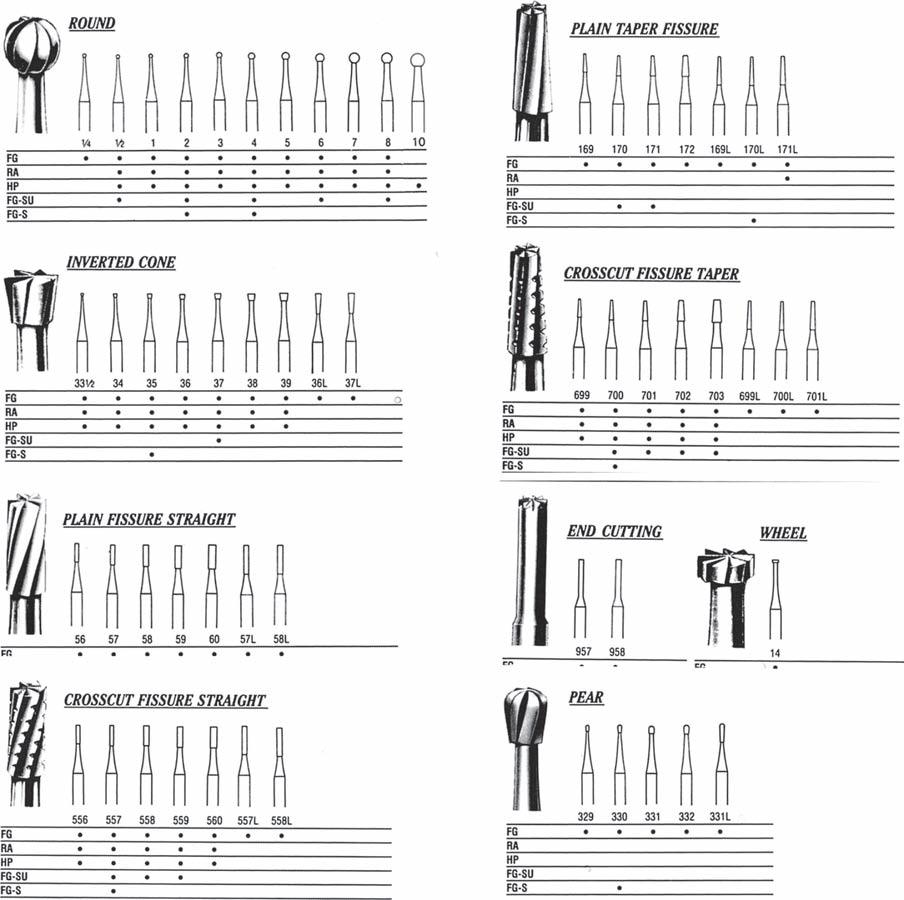
Figure 4-10 Examples of burs
Courtesy of Integra LifeSciences Corporation through Integra Miltex
Figure 4-11
Mandrels with different heads and shanks

Miscellaneous Rotary Instruments
Several other instruments may be used in a rotary handpiece: mandrel (MAN-drell): a slim, metal holding device that fits into slow handpieces and is used to smooth and cut. They may have RA or HP end fittings and come in various lengths. Mandrels hold abrasive and rubber discs by a screw-on or snap-on method (see Figure 4-11). The Joe Dandy, a thick, carborundum disc, is very popular. stone, wheel, and discs: abrasive or chemically treated discs, wheels, cups, and points with various shapes that can be permanently mounted or glued on a shaft or placed on discs for mandrels. They are supplied in assorted sizes and grit (abrasiveness) and are used for smoothing at chairside or in the lab (see Figure 4-12). diamond rotary instruments: pulverized industrial diamonds glued on a shaft or disc and commonly called burs or points. They are used to cut, smooth, and rapidly reduce tissues; they follow the same numbering pattern and color-coding as steel burs. bur block: a tray device used to hold the small rotary instruments during use at the chair and while being sterilized; may be metallic or resin and may or may not have a cover.
Figure 4-12
Various grit types of stones, wheels, and points
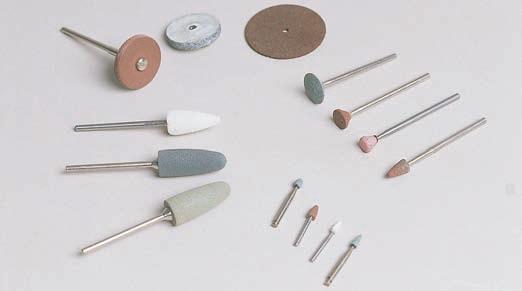
Dental Facility Operative Equipment
Each dental facility or clinic contains specialized dental equipment that is used to perform necessary treatments. Although many items are available, some for general dentistry and some for specialty use, all facilities need the basic items shown in Figure 4-13 and described here: operatory (OPERA-tory): small treatment room equipped with dental appliances. Some practices, such as orthodontic, and some clinics have a single large operatory area containing several chairs and necessary equipment separated with half walls or room dividers. dental chair: chair appliance, usually electrically powered, that raises, lowers, and tilts to provide easy access and proper vision; may be a lounge or upright chair style. Most chairs are operated by remote foot controls to eliminate hand use and contamination. operatory light: viewing light for patient care; may be wall mounted, on a floor stand, lowered from the ceiling, or attached to the chair unit. The light may be dimmed or the beam calibrated for specific vision needs.
Some lights are activated by motion sensor devices, eliminating touching and contamination. stools: movable seats for the dental personnel. Stools have height adjustment and back rests. Some stools have torso rests extending in front for forward-leaning support. dental unit: upright, stationary, or movable table-style working appliance that provides handpiece power, aspiration, water, and air. Some units also provide electrosurgical power, a natural gas outlet, fiber optic power, and custom appliances such as intraoral cameras, laser handpieces, perio-pocket depth sensors, air abrasion units, curing lights, pulp depth indicators, and crown shape fabricators. cabinets: mobile, floor-, or wall-mounted storage cabinets with drawer space for supplies and equipment. radiographic units: various configurations; a dental practice may have a radiographic control unit in a central area with the X-ray head or power source in each operatory area; other facilities have head and control units in the operatory room or may use a separate radiographic area for panoramic, cephalometric, or 3D exposures; some have filmless, digitalized radiographic units using sensors, computer-assisted viewing and imaging, or portable X-ray exposure heads. diagnostic or auxiliary units: include perio-pocket detectors, newly developed electronic diagnostic devices used to assist with a patient survey; endodontic units detect the depth of instrument probing to avoid accidental penetration of the apex. Laser dental surgery, electronic target anesthesia, computer interaction, charting recording, ultrasonic cleaning methods, and other new units to aid the dental profession are being introduced continually as well.
Figure 4-13
Dental operatory or treatment room
Review Exercises
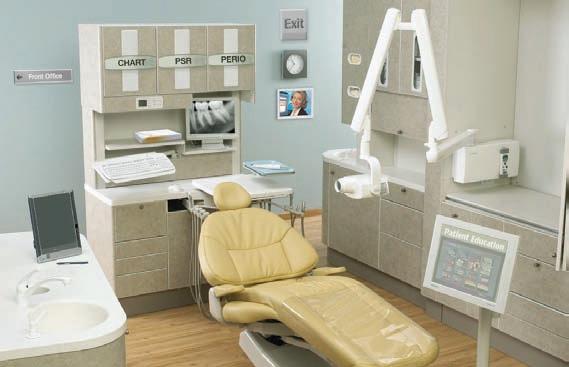
Matching
Match the following word elements with their meanings: 1. _____ pedodontist A. bur type used to fit in straight handpiece 2. _____ PFI B. combination instrument = explorer and periodontal probe 3. _____ shank C. fine-pointed instruments with depth-measuring marks 4. _____ cotton forceps D. rotations per minute, speed of handpiece 5. _____ endodontist E. specialist who performs children’s dentistry 6. _____ DDS F. high-volume evacuation system 7. _____ hoe G. hand instrument used to remove and dig out decay 8. _____ FG H. hand instrument used to break away or pull off enamel 9. _____ HVE I. specialist who treats diseased gingival tissues 10. _____ rpm J. Doctor of Dental Surgery 11. _____ expro K. dressing pliers 12._____ periodontist L. high-speed or friction grip bur 13. _____ probe M. connects instrument handle to working end 14. _____ HP N. specialist who treats internal pulp tissues 15. _____ excavator O. instrument used to carve pliable restorative material
Definitions
Using the selection given for each sentence, choose the best term to complete the definition. 1. A hand instrument with a thick head, used to push or pack down material is a/an: a. condenser b. hatchet c. curette d. discloid-cleoid 2. People who are trained in a specific field and considered knowledgeable in that area are: a. lay people b. professionals c. expertizers d. apprentices
3. A person who independently specializes in denture construction is a: a. dental detail person b. denturist c. dental practice consultant d. lab technician 4. Which part of an instrument is used to grasp or control the instrument? a. working end b. blade c. nib d. handle 5. Which of the following specialists works on common dental diseases of the community? a. public health dentist b. forensic dentist c. pediatric dentist d. surgeon 6. The rounded end of working part of a hand instrument is called a: a. toe b. tip c. nib d. blade 7. Which of the following specialists replaces missing teeth with artificial appliances? a. prosthodontist b. periodontist c. pedodontist d. endodontist 8. A two-edged, rounded toe, cutting instrument used to remove subgingival calculus is a: a. scalpel b. universal curette c. gingival margin trimmer d. sickle scaler 9. A non-metallic, resin-tipped hand instrument used to clean and remove deposits around pegs and abutments is a/an: a. periodontal knife b. plastic filling instrument c. implant scaler/curette d. hatchet 10. Another word for the handle of a hand instrument is: a. shank b. neck c. working end d. shaft 11. A handpiece with the head set at a 90-degree angle is which type of handpiece? a. straight b. contra angle c. right angle d. prophy 12. The end of the bur that is inserted into the handpiece is called the: a. shank b. neck c. head d. tip 13. Which of the following would not be inserted into the handpiece to become functional? a. mandrel b. matrix c. mounted stone d. bur 14. Which of the following auxiliary units is used to incise and coagulate tissue? a. air abrasion b. light curing c. ultrasonic d. electrosurgery 15. Which of the following are group members of the basic instrument setup? a. mirror, explorer, cotton pliers, probe c. periodontal probe, chart, mirror, hoe b. mirror, excavator, matrix, probe d. explorer, mirror, handpiece, matrix 16. A hand instrument used to smooth off or contour restorative material or metals is a/an: a. matrix b. condenser c. burnisher d. explorer 17. A retaining or holding device used to make an artificial wall in a restoration is a: a. retainer b. mandrel c. matrix d. dental dam 18. A hand instrument used to incise (cut into) or remove tissue is a: a. carver b. scalpel c. beaver-tail burnisher d. hatchet 19. The national organization for dental assistants is the: a. DANB b. ADA c. ADAA d. CDAA 20. A gingival margin trimmer is used to: a. break away the enamel side of a tooth during preparation b. remove supragingival and subgingival deposits from tooth margins c. maintain margin walls during the insertion and condensing of materials
Building Skills
Locate and define the prefix, root/combining form, and suffix (if present) in the following words: l. prosthodontist prefix ___________________ root word/combining form ___________________ suffix ___________________ 2. gingival prefix ___________________ root word/combining form ___________________ suffix ___________________ 3. evacuator prefix ___________________ root word/combining form ___________________ suffix ___________________ 4. periodontal prefix ___________________ root word/combining form ___________________ suffix ___________________ 5. denturist prefix ___________________ root word/combining form ___________________ suffix ___________________
Fill-Ins
Write the correct word in the blank space to complete each statement. 1. The high-speed vibrating instrument used for scaling and curettage of teeth is called a/an ______________________________________ scaler. 2. The portable mobile seats used by dental personnel in the operatory area are called _______________________________________. 3. Persons who have not been trained or experienced in a particular trade or study are called ________________________________________.
4. When incision and immediate coagulation of the site is desired, the dentist will select the ___________________________ handpiece. 5. A hand instrument used to transfer amalgam while in a plastic stage is a/an ________________________________________ 6. Hand instruments may have working heads on each end; this type of instrument is called a/an ____________________________ instrument. 7. The three components of a hand instrument are _____________________, _________________, and ____________________________________. 8. A rounded blade end on a hand instrument is called a/an ______________________________. 9. A pointed blade end on a hand instrument is called a/an ________________________. 10. Name three instruments used in the basic exam setup: __________________________________, ____________________, and _______________. 11. Three purposes for the use of a mouth mirror are ____________________________________, _________________ and __________________. 12. Cotton forceps or pickups are used to _______________________________________. 13. Three interworking items used to maintain artificial walls around a cavity prep are ___________________, ___________________, and ____________________________________. 14 Two initialed titles that indicate a person is trained as a dentist are ______________ and _______________________________________. 15. A ___________________________ is a device used to hold rotary burs during procedures and through sterilization. 16. Three parts of a rotary instrument called a bur are _________________, __________________, and ____________________________________. 17. Shortened burs are called __________________. 18. A latch-type handpiece will require the _____________________ type of rotary bur.
19. Crosscut or extra teethed burs are called ________________________________________. 20. Another name for the foot pedal that controls the speed of the handpiece is a/an ________________________________________.
Word Use
Read the following sentences, and define the boldfaced word letters. 1. Many assistants enjoy the diversity of working in a group practice. ________________________________________ 2. When faced with the gross removal of tooth structure, the dentist may choose a dentated type of rotary bur. ________________________________________ 3. The chemical bleaching treatment of the pulp canal may be performed by the endodontist. ________________________________________ 4. It is difficult for a new assistant to learn each specific armamentarium for each different procedure. _______________________________________ 5. The patient commented that the operatory was bright and colorful. _______________________________________
Audio List
This list contains selected new, important, or difficult terms from this chapter. You may use the list to review these terms and to practice pronouncing them correctly. When you work with the audio for this chapter, listen to the word, repeat it, and then place a checkmark in the box. Proceed to the next boxed word, and repeat the process.
armamentarium (ar-mah-men-TARE-ee-um) cleoid (KLEE-oyd) curette (kyou-RETT) cuspidor (kuss-pih-DORE) dentated (DEN-tay-ted) denturist (DEN-ture-ist) endodontist (en-doh-DAHN-tist) excavator (ECKS-kah-vay-tore) forensic (for-EN-sick) mandrel (MAN-drell) matrix (MAY-tricks) maxillofacial (mack-sill-oh-FAY-shul) operatory (AH-purr-ah-tore-ee) orthodontist (ore-thoh-DON-tist) pediatric (pee-dee-AT-trick) periodontist (pear-ee-oh-DAHN-tist) prosthodontist (prahs-thoh-DAHN-tist) rheostat (REE-oh-stat) scalpel (SKAL-pell) truncated (TRUN-kay-ted)










